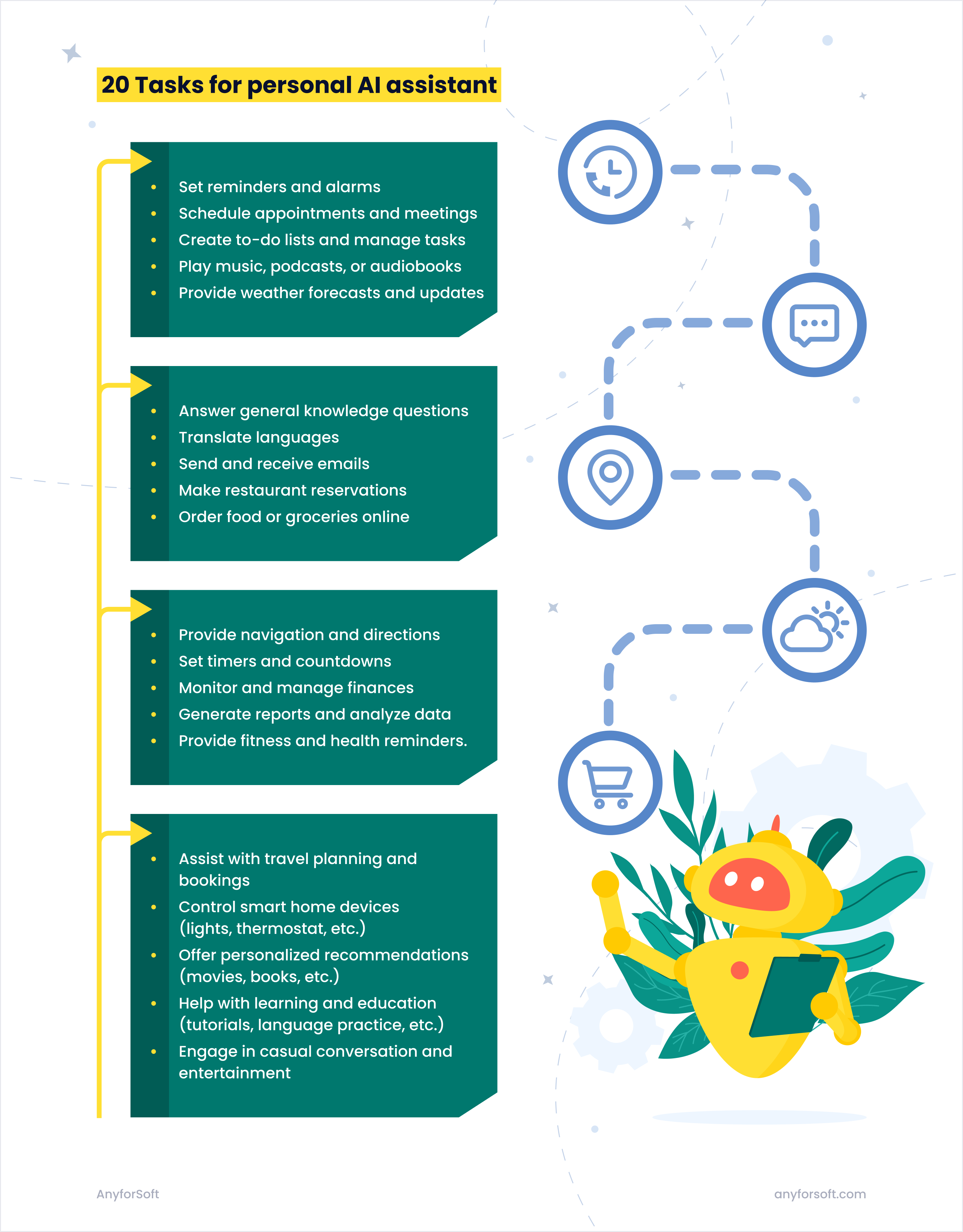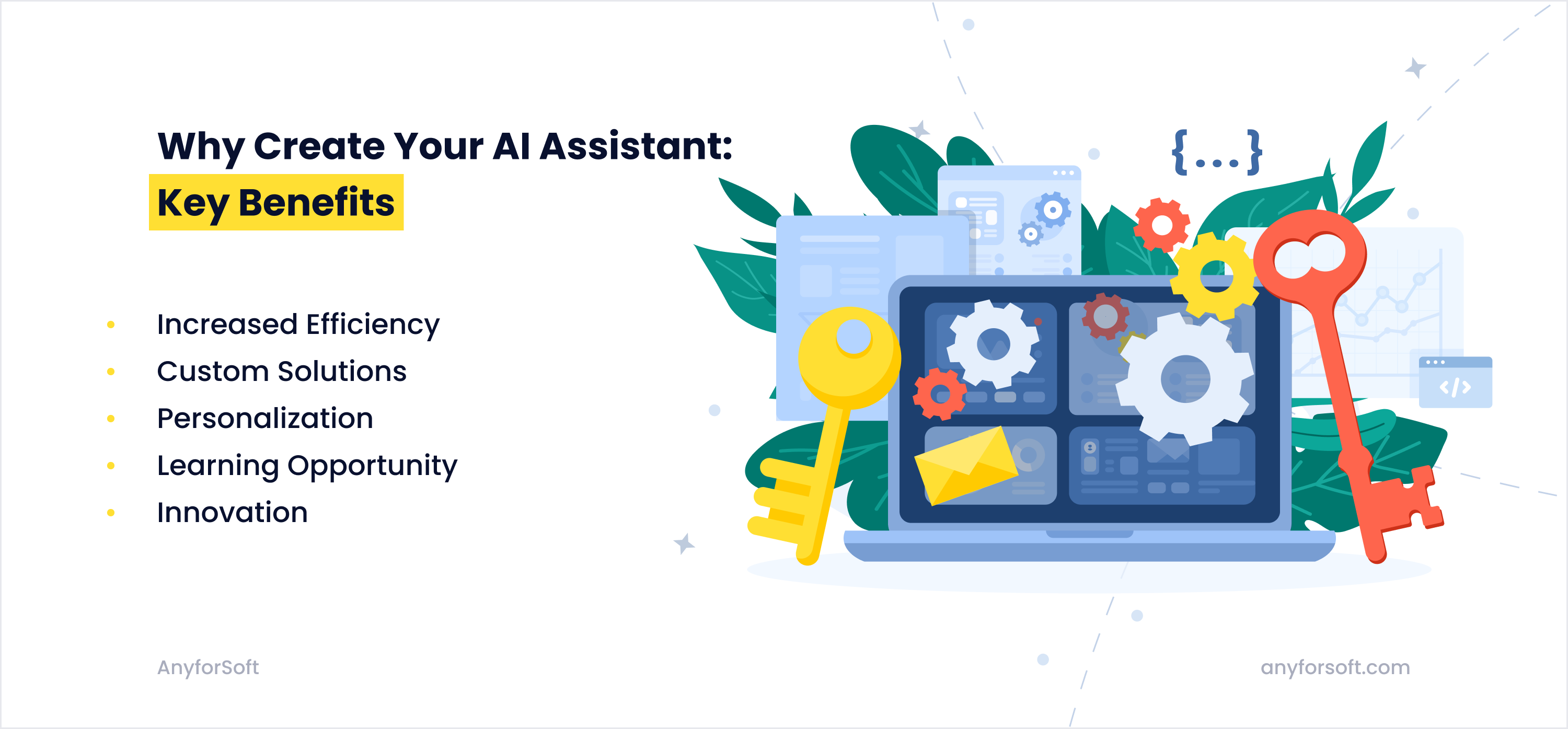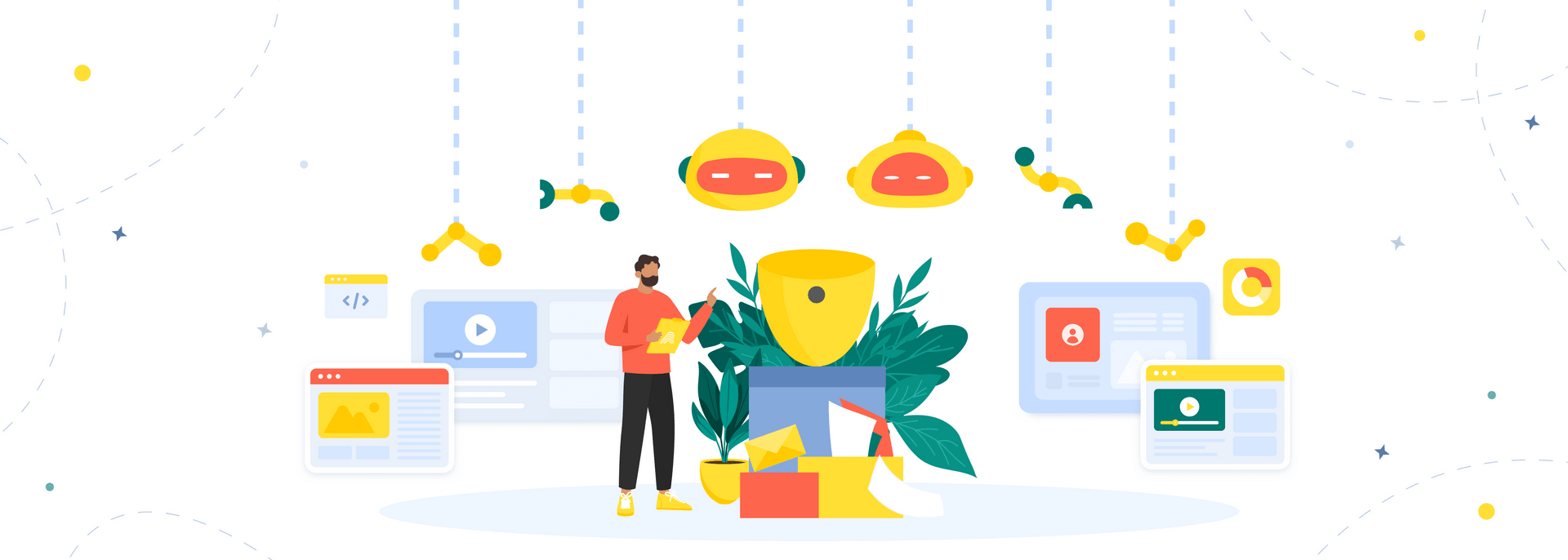Artificial intelligence (AI) has subtly become a part of our daily lives, much like a genie residing in our smartphones and other gadgets. The assistant that will instantaneously find all the information you need, put all your schedules together, and even optimize the workflow for you.
Remarkably, about 35% of businesses have already embraced AI technologies, and a vast majority of individuals engage with AI, often unknowingly. Beyond popular platforms like ChatGPT, AI's capabilities extend far wider. Are you intrigued by the possibility of crafting a bespoke digital helper that would make your life much more comfortable and productive? If so, you've landed in the perfect spot to learn how to make an AI assistant that is always at your service.
What is a Personal AI Assistant?
In straightforward terms, artificial intelligence, or AI, signifies any device, program, or robot capable of functioning with intelligence. With AI technologies, it is possible to create mechanisms that will think and, most importantly, learn as people do. It is, in its essence, the best of two worlds — a combination of high technologies and people-like technologies. Ultimately, AI consists of algorithms designed to replicate humans’ actions and behaviors. This concept includes machine learning and deep learning: these processes allow machines and special systems to learn something and “become smarter”. Be it setting your morning alarm or navigating city traffic, AI assists quietly and efficiently, becoming a vital part of modern life. Intrigued? Well, this is just a glimpse of AI's vast potential.

The Basics of AI Technology
A properly conducted analysis of artificial intelligence shows that it is present at many levels of our lives. AI systems can handle a wide variety of tasks at different difficulty levels, from reminding you to take the chicken out of the freezer or playing your favorite song to recognizing your speech and deciding on the best route for you to drive. At its core, AI is simply distilled down to two main components: data and an algorithm. Data gives AI insight, whether in text, image, or sound formats, while algorithms process this data to make decisions, learn from outcomes, and even predict future events.
The magic of AI is in the processing capabilities it offers: it can analyze huge amounts of information and do it fast and effectively. This allows it to define general trends, automate its responses, as well as personalize it. It can also keep learning so it can bring higher levels of accuracy and utility to an action with new data and feedback. The way how this ability manifests itself can be seen, for example, in comparing a conventional search engine with a search engine based on artificial intelligence. While the former operates purely on basic keyword matching algorithms, AI-powered site search uses natural language processing. Thanks to this, the AI-driven search engine understands you perfectly and knows what you are looking for, even if you don’t know how to word your request. It almost feels eerie, doesn't it? Imagine an AI that learns your preferences in music or your needs in scheduling—this personalization is what makes AI so unique and powerful in today's tech-driven world.
AI should not be thought of as the mere imitation of human intelligence. Instead, it should be seen as a means of enhancing human interaction in the way their lives are made better, interconnected, or intelligent. As of this time, AI is being used to help assist in the management of homes, improve the health of individuals, and remodel industries entirely, with perceptions of entirely new uses emerging daily.
Types of AI Assistants
Before exploring how to create an AI assistant, it's beneficial to familiarize yourself with their primary categories. AI assistants can be categorized based on their application (the specific goals they are designed to achieve) and their form or the interaction modes they use to communicate with users. Here are the most prevalent types of AI assistants:
Chatbots
These AI systems are designed to simulate conversation with human users, especially over the internet. They are extensively used in customer service and support to handle queries or provide information. Customer service bots set up by companies, or shopping bots on e-commerce sites, are the most well-known examples.
Voice Assistants
Popular AI assistants like Siri, Alexa, and Google Assistant are widely recognized for their ability to assist with daily activities such as setting reminders, playing music, updating weather forecasts, and controlling smart home gadgets. Sometimes called conversational AI, these assistants benefit from the advanced speech recognition technologies that allow for processing the spoken commands and support the hands-free type of interaction with the multiple devices. In addition, they have the skills of not only understanding lots of accents and dialects but, in some situations, even distinguishing the voices of different people. We have already written about what these AI talkers can do, as well as how they differ from their silent counterparts in chatbot vs conversational AI comparison analysis.
AI Avatars
Although AI avatars share many functionalities with more traditional, non-visual AI assistants, the incorporation of a visual, often humanoid representation adds distinct characteristics and capabilities. Due to the visual presence, interaction between the user and the avatar might be more engaging and human-like. It can help in various scenarios that require high user engagement, like healthcare, education, or customer service provision.
Specialized Task Assistants
This category includes AI assistants that are created for some specific business domain to help with the field- or industry-related activities. They often integrate domain-specific knowledge and tools to enhance user experience and efficiency. For instance, online shopping assistants help with all the stages, ranging from searching for goods to purchasing and tracking one’s order. While healthcare assistants facilitate managing patient care, scheduling, and administrative tasks in medical settings.

Key Benefits of a Personal AI Assistant
There is no need to explain what a perfect service can mean to people and businesses, and having your personal helper may well be a breakthrough for both. The smart system not only helps to make the work process easier. It also brings the deepest benefits, which might turn the most common actions into individualized and efficient ones. Below are the major advantages of having a digital helper in the current world.
Increased Efficiency
AI assistants make users more efficient for several reasons. First, smart systems accomplish routine tasks like scheduling and organizing emails and reminders, giving people time to engage in brainier activities. Based on the survey conducted by McKinsey & Company, AI can boost business efficiency by up to 40%. Moreover, since such systems are frequently voice-activated, it allows the users to multitask, completing such chores as scanning emails while exercising which saves time as exercisers can then do more work overall.
Custom Solutions
A custom AI assistant is a tailor-made solution created to address particular business challenges and meet unique preferences. By designing an AI specifically for your operational needs—be it enhancing customer service, streamlining inventory management, or supporting in-depth analytics—you ensure that the technology works precisely as needed.
Personalization
AI assistants are perfectly suited to personalization. They remember every user’s preference to provide a more custom experience. It’s beneficial for the business, as it allows companies to offer their clients personalized recommendations and assistance. Furthermore, a personalized assistant can remember all the past interactions with a user, so each new meeting is smoother and more intuitive. Both the user and the business benefit from this quality as it allows for creating a more profound bond.
Learning Opportunity
It is a unique chance to gain knowledge and invaluable skills during the process of building your own AI assistant. This project brings you to the fascinating world of artificial intelligence, machine learning, and natural language processing. And, most importantly, it helps you not only to know the way they can be applied but to understand how they work thanks to this understanding of the ways to launch intriguing real-world apps.
Innovation
The creation of an AI assistant is an innovation catalyst. It brings you to the forefront of innovation. You will understand how voice recognition is integrated and how chatbots are built. Equipped with these tools, you'll grow your technical skill set and uncover new methods for solving personal and business challenges.

How to Build Your Own AI Assistant?
Now it's time to answer the main question that probably brought you here: how to create your own AI assistant? With a combination of the right technologies and tools, this can be done in the following five steps.
Step 1: Define the Objective of Your AI Assistant
The first step of building an AI assistant is identifying what tasks the AI assistant should perform and what problems it's meant to solve. This phase involves getting to know the target users and establishing clear goals and features for the assistant.
Identify User Needs:
Begin by identifying the needs of the end-users who will interact with the AI assistant. For instance, if the assistant is for customer service, what are the common inquiries or issues customers face that the AI can resolve? Grasping these needs can clarify the tasks that the assistant should focus on first.
Business Goals Alignment:
Consider how the AI assistant can align with and advance broader business goals. For example, if reducing operational costs is a goal, an AI assistant designed to automate routine tasks or handle high-volume customer queries can directly contribute to achieving this.
Scenario Analysis:
Envision realistic scenarios in which the AI assistant would be used. For instance, if you’re developing an assistant for a retail business, scenarios might include helping users find products, providing stock information, or facilitating purchases. Following the sub-steps mentioned will guide you in choosing the best technology for your assistant. For example, many businesses face the “generative AI vs predictive AI” dilemma, but if you know how and what your digital assistant will be used for, this will no longer be an issue for you.
Technology Assessment:
Assess the technological capabilities and limitations that could influence the AI assistant's functionality. This can help refine the objectives to be both ambitious and achievable with available technology.
Step 2: Design the User Interaction
Designing user interaction for an AI assistant involves crafting how the assistant communicates and functions in response to user inputs. Creating a seamless and engaging user experience is crucial at this stage. The best way to start is by planning conversation flows, considering common user prompts and the assistant's responses. The UI should be familiar, allowing users to easily navigate and interact (through voice commands, text inputs or touch gestures).
Equally important is defining the assistant's tone and personality. Decide whether it should be formal, friendly, humorous, or straightforward based on your target audience and brand identity. Consistently reflecting this personality across all interactions makes the experience more relatable and enjoyable for users.
Step 3: Choose the Technology and Platform
To build an AI assistant, you should choose the right technology and platform. The choice depends heavily on the intended use case, deployment environment, and specific features you want to incorporate.
Technologies:
- Natural Language Processing (NLP) tools like Google’s Dialogflow, IBM Watson, or Microsoft’s LUIS can be used to understand and process human language.
- Voice-based assistants rely heavily on speech recognition technology, and options like Google’s Speech-to-Text and Amazon’s Alexa Skills Kit are among the best.
- TensorFlow and PyTorch are machine learning platforms that help the AI get better at responding and behaving by learning from user interactions over time.
Platforms:
- Mobile and Web: Determine if the assistant will be integrated into existing mobile apps, websites, or both, requiring compatible frameworks.
- IoT and Hardware: For assistants meant to control or interact with physical devices, platforms like Raspberry Pi or Arduino might be involved.
- Cloud Services: Many AI assistants rely on cloud platforms like AWS, Azure, or Google Cloud for scalable processing and data storage.
Choosing the right mix of technologies and platforms makes sure the AI assistant works well, can grow with demand, and provides a smooth user experience.
Step 4: Develop and Train the AI
At this stage, there are several options for plot development, depending on the complexity and how customized you want your AI assistant to be. Developing a complex AI assistant from scratch, especially if it is an AI avatar or voice assistant, requires coding knowledge. While there are user-friendly platforms and tools that streamline the process and require minimal coding, creating a sophisticated AI assistant often requires custom development to meet specific requirements and integrate advanced functionality. So, if you lack the technical know-how, you'll probably need help from experienced developers.
For basic AI assistants, you can use user-friendly platforms and frameworks that offer drag-and-drop interfaces or pre-built modules. These platforms also come with templates and guides, so you generally do not have to write much code, particularly any complicated one. In any case, knowing the basics of AI, like machine learning, NLP, and data handling, can be advantageous. It will give you a better grasp of the AI you create and might make it easier to train or fine-tune it.
Now we have to teach the AI assistant to do its job. This means giving it lots of data and examples to learn from. It's like teaching a child new things, but instead of books, we use algorithms. This AI child learns from the data given to it, and over time it becomes mature and starts recognizing patterns. All that is left is to train it to answer any questions or complete every task that can be given to it.
Data for training AI assistants can come from different sources. One common source is existing databases or datasets related to the task the assistant will perform. For example, if it's a customer service assistant, we might use customer inquiries and responses from past interactions. Alternatively, we can also use online sources like websites, forums, and social sensitive data such as Facebook and X among other platforms, which will enable us to have a lot of information based on real-world issues.
Also, artificial intelligence can be taught in several ways using algorithms. These include supervised learning when we treat the AI with labeled examples of input and output cases. For instance, if we want the AI to understand language, we feed it pairs of sentences and their meanings. This way it learns and adjusts its parameters to make predictions.
Step 5: Test, Deploy, Maintain
The final step in creating an AI assistant is crucial for ensuring its reliability and effectiveness. Start with rigorous testing to catch any errors or glitches. This implies functionality testing to ensure all features work as designed and user acceptance testing that the assistant meets the requirements and expectations of the end-user.
Once testing confirms the assistant is stable and functional, proceed to deployment. This might involve integrating it into a live environment, whether it's on a website, in a mobile app, or through a smart device system. Careful monitoring during the initial launch phase is essential to address any immediate issues that users encounter.
Maintenance never stops. Continuously collect user feedback to refine and update the assistant. Regularly feed the AI new data to boost its learning and analysis skills, keeping it up to date and helpful. This cycle of feedback, updates, and training keeps the assistant performing at its best.
Conclusion
As we've discussed, creating an AI assistant brings many benefits, from simplifying tasks to improving personal interactions. If you are striving to increase your business productivity or just make your life more comfortable, an AI assistant might be the best choice. Therefore, in case you have any more questions or need expert advice on how to create your own AI assistant, don't hesitate to contact Anyforsoft. Our seasoned development team is ready to give you customized advice and assistance, designed to meet your unique needs.
